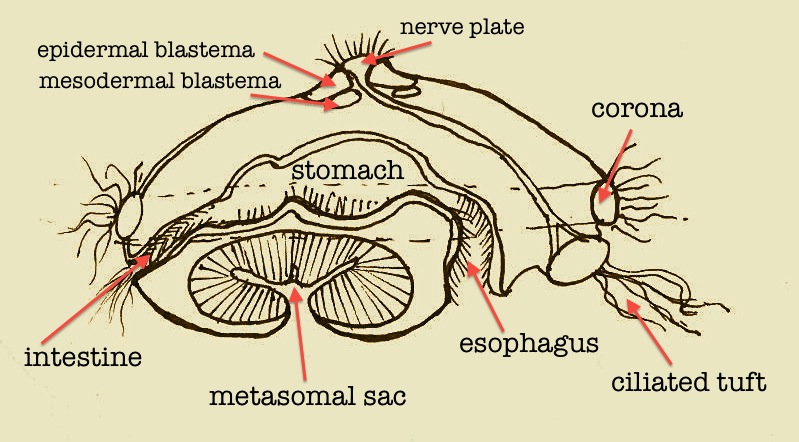Development and Settlement
Cleavage of the embryo is typically even and total with a radial pattern of tiered cells. The beginning of gastrulation involves the division of the four cells at the vegetal pole as they form the entoderm.

|
|
External anatomy of two types of Gymnolaemate larvae. Adapted from Ruppert et al. 2004. |
The blastocoel fills with the mass of daughter cells and eventually larger, ciliated cells that form an equatorial ring known as the corona, which gives the larvae mobility. The ectodermal cells of the animal pole differentiate to form a sensory organ (Ryland 1970). The ciliated corona, apical tuft and ventral metosomal sac appear in all bryozoan larvae, though the external appearance and behavior between species can vary. Most gymnolaemates produce lecithotrophic coronate larvae which spend a short amount of time in the water column and thus have a limited dispersal range.

|
|
Internal anatomy of a generalized Gymnolaemate larvae. Adapted from Zimmer and Woollacott 1977. |
These larvae will not have a functioning gut and are therefore pressed for time to find a suitable settlement area. Planktotrophic cyphonaute larvae also exist in the gymnolaemates (such as Electra and Membranipora), sometimes taking months to settle (Ryland, 1970).
Larvae have been shown to be phototaxic, and are influenced by chemical cues, complexity of the substratum, and water movement, while the size, age, and genotype of a larvae can profoundly influence where it settles as well (Burgess et al. 2009). The larvae attach to the substrate with their metasomal sac, which distends, adheres, and proceeds to secrete a cocoon to enclose the larva as it metamorphoses. Within the cocoon, the larval epidermis migrates inwards to become the lining of the adult coelom (Ruppert et al.2004).
The first zooid is known as the ancestrula from which all following zooids are the descendants through asexual budding. New daughter zooids begin as simply the cystid (body wall) from which a new polypide develops. The pattern in which the daughter zooids bud from and form partitions between the ancestrula determines the ultimate shape and structure of the colony (Ryland 1970). However, despite being genetically identical there are a number of zooid polymorphisms which are particularly abundant in the cheilostomes (see COLONY STRUCTURE).
|